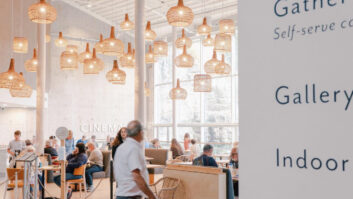Big name films are finally hitting the big screen, but cinema has not returned to pre-Covid levels and doubt remains over its long-term future. According to figures released by box office tracker Comscore, the takings at UK cinemas for the month following the lifting of all Covid restrictions in England were half what they had been pre-pandemic.
The situation in the US is similar, with the last four weekends up to 20 August being 51 percent down on two years ago. Despite this, Comscore reported UK cinema operators as saying they were “very pleased” with the figures and “pretty confident” there would be a return to how things had been before.
The sector as a whole is trying to be positive – not easy after 18 months of lockdowns and uncertainty. “The recovery is well underway and there is a great deal of confidence and optimism in the sector,” confirms Phil Clapp, chief executive of the UK Cinema Association. “We’re not pretending there are not setbacks, such as the decision to push Top Gun: Maverick into 2022, but the slate remains a strong one, with, of course, Bond to look forward to at the end of September.
The new James Bond film, No Time to Die, was originally slated for April 2020, then put back to November and yet again to April 2021. It was later postponed to this September 30, still with the hope that, regardless of the delays, 007 will pull in the punters. Even so, the industry remains circumspect. “There’s no expectation that we will be reaching pre-Covid levels of success – 2018 and 2019 being the best years for UK cinema-going since 1970 – before year end but there is every hope that the recovery will see us reach that point into 2022 and beyond,” says Clapp.
This success and popularity was also seen in other territories, including Japan, France, the Netherlands and Poland, although in 2019 the US had its second lowest attendance this century. The situation before Covid is confirmed by Carl Rijsbrack, chief marketing officer and head of innovation at Cinionic: “Many pre-pandemic industry reports show an increase in the global box office, along with rising theatre attendance.”
Cinionic was founded in 2018 as a joint venture by Belgian projection specialist Barco, laser display manufacturer Appotronics and the China Film Group (CFG). It has concentrated on improving cinematic visuals through a variety of technologies, including the Cinionic Giant Screen (CGS) and ALPD (advanced laser phosphor display) projection. Rijsbrack says the aim was to deliver “‘wow’ experiences” to visually stun the audience.
Prior to the pandemic, Rijsbrack says, exhibition technology was undergoing a shift as the sector went into a wave of renewal, driven by the rapid adoption of laser projection. “The events of the last two years have only sharpened the resolve of the industry to continue delivering the best cinematic presentation in a dedicated movie-going space,” he adds. “We are now seeing the trends that started before the outbreak of Covid accelerate as we collectively work to welcome audiences back to movie theatres.”
New technology was already regarded as a way to offer cinema-goers something different to home streaming and hopes are now pinned on it bringing them back post-Covid. “Much has been said about
the many challenges faced by theatres during the pandemic and throughout we’ve stood with exhibition to provide support and tools to navigate these times,” comments Rijsbrack. “Yet we’ve seen that where there is content available, confidence in safety measures and the ability to open theatres, people are returning. We only need to look at the recent box office results to see that global audiences are seeking out cinema for its unrivalled viewing experience.”
BLOCKBUSTER DRAWS
The apparently insatiable appetite of moviegoers for big blockbusters, particularly those featuring DC and MCU superheroes, doubtless played a part in ensuring cinema was still a draw pre-Covid. Technology was also a major factor in this, with high resolution visuals and immersive audio creating an all-encompassing environment for effects-heavy filmic extravaganzas.
On the picture side, premium large format (PLF) screens have grown in number considerably, from just over 1500 installations in Europe in 2014 to more than 3500 by 2018. IMAX, with its high aspect ratio and wrap-around effect, is the most recognisable PLF system but other bigger screen formats have appeared in recent years to challenge it. These include CGS, DMAX (developed by CFG), Odeon’s iSense and Cineworld ScreenX. Another major exhibitor, Vue, has its VueXtreme offering, which comprises IMAX and 4K projection. Specialist systems integrator CinemaNext developed Sphera, which offers 4K, HDR (high dynamic range) and 3D components, while Dolby has Dolby Cinema. This combines Atmos immersive audio technology with the Vision proprietary HDR format.
Post-Covid, PLF may be crucial in bringing audiences back to movie theatres. “In the last two years people have got used to sitting at home on their couches and watching something on their television,” comments Mark Collins, senior manager for global cinema at HARMAN Professional Solutions. “To get them off the couch, we need to show them a premium experience. People are just not going to accept sub-par auditoriums any longer. If they’re going to spend that extra money, they’re going to want to see big movies on the best thing possible, a big screen with a big sound system.”
Sound certainly plays as important a role as the visuals in creating excitement, drama and atmosphere. The ultimate aim has been for a truly immersive system that would complement high resolution, big screen presentations and envelope the audience. That has now been achieved through object-based audio
(OBA) systems: Dolby Atmos, DTS DTS:X and Auro Technologies’ AuroMax (the developer also produces the channel-based 11.1 Auro-3D immersive system).
Loren Nielsen, vice president of content and strategy at Xperi Corporation (which bought DTS in 2016), says DTS:X has “a strong presence in China” and is increasing its share in Europe and the US. “When DTS decided to get back into cinema business [after previously selling that side of its portfolio in 2008] it was in support of object-based immersive technology to be across the whole eco system: cinema, home, mobile and streaming,” she adds.
Nielsen observes that the pandemic has proved “extremely difficult” for distribution and theatrical in general. “In Europe it was a little easier for distributors because of government support, unlike the US,” she says. “But that doesn’t replace a thriving business. And the pandemic continues to have an impact. We thought in June that [the market] was returning – F9 [the ninth in the Fast and Furious franchise] was a highly successful release – but studios are still holding releases, shifting them into late 2020 and 2021. That was if they were released theatrically at all or went straight to streaming or had a hybrid release.”
On top of other problems, the cinema sector is facing the reality of what Nielsen calls being “over-screened”, with too many screens chasing too few people. “The success of streaming is that there is so much content to choose from and you can see it when you want,” she says. “But people still want the special experience of theatrical, with something like PLF, which is where DTS:X sits. Cinema is also a shared experience and some have done a great job in providing a community experience. Maybe there won’t be as many titles released theatrically in the future and the focus will be on a premium experience – and immersive audio is an important part of that.”
The three object-based immersive audio systems are incompatible but films can be delivered to cinemas and then played out in the venue’s preferred format due to the SMPTE ST 2098 interoperability standard, published in 2019. “There have been some changes on the IMF [interoperable master format] file for digital cinema, which is going to be much more universal,” says Collins. “The final product that’s sent to the theatres will no longer be either a proprietary Auro or DTS or Atmos file. It’ll be a single file format and then it’s up to the processor to deal with it.”
Wilfried Van Baelen, chairman of Auro Technologies, comments that Auro began discussions with SMPTE as it started work on ST 2098 to create a common standard. “It took many years before a final solution was found between all parties but ST 2098, which includes AuroMax, was published a few months before the Covid pandemic happened, which was very unfortunate timing for us,” he says.
Had coronavirus not struck when it did, the wider availability of immersive audio formats due to ST 2098 and the IMF might have increased cinema audiences and kept the streamers at bay. Despite this, Van Baelen says he does see the market beginning to come back: “Which is fantastic news because the cinema is a unique experience. If it recovers to the level it was before is hard to predict. History has taught us that one incredible movie can make the difference. But I believe this time more is needed in order for recovery. People need to have an experience that is hard to get at home. The technology is there to install immersive audio but so far only two percent of all cinemas worldwide have it.”
FERTILE GROUND
While the installation of immersive sound systems in cinemas remains a small percentage of the overall market, Van Baelen says the home market is proving fertile ground for the tech. “With the first lockdown last year, the number of home installs with Auro-3D suddenly increased more than 200 percent in one quarter,” he says. “It was very clear people invested extra money in order to have a better AV experience. Once people have had such a good experience at home, it will be hard to bring most of them back to theatres that don’t have an immersive sound system.”
Home cinema has been developing since the 1990s, with more affordable separates systems encouraging take up. In the last few years, largely because Netflix and Amazon have presented both films and TV series in 4K and Dolby Atmos, people were already looking to install the best possible equipment and take advantage of the higher quality pictures and sound. Being confined to quarters during the pandemic increased this trend, as shown in the annual study of UK media habits by regulator Ofcom.
These findings have been good news for the UK’s home theatre equipment installers and suppliers, according to Matt Nimmons, managing director of trade association CEDIA for EMEA. “Adults in the UK sought solace in screens and streaming in 2020, spending a third of their time watching TV and online video,” he says. “The daily average was five hours and 40 minutes – 47 minutes more than in 2019. Ofcom says this change was mainly driven by people spending almost twice as much time (one hour and five minutes per day) watching subscription streaming services such as Netflix, Amazon Prime and Disney+.”
Nimmons comments that CEDIA members were called in to “transform homes with dedicated cinemas or media rooms”, installing bigger screens and “powered up” audio. “The market has certainly broadened out but home cinema, in our view, is not a DIY market,” he says. “A living room with a big TV screen and speakers is a multi-functional media room, not a home cinema, but increasingly that set up is just not enough for a growing number of consumers.”
Christopher Mullins, product manager for home cinema at Sony Professional Displays and Solutions, agrees this kind of system will typically be in a dedicated space – “essentially a dark room with large screens”. While this remains “the core market”, Sony is also seeing a demand for multipurpose rooms to have large screen projectors installed. “Multipurpose room budgets vary in the same way as dedicated spaces, based on the requirements of the consumer,” he says.
On the audio side, Sony has the Vertical Surround Engine, which is able to create virtual surround from either a pair of loudspeakers or a soundbar, such as the new HT-A7000. Sony also has its own immersive audio format, 360 Reality Audio, as well as 360 Spatial Sound Mapping technology, which can form up to 12 phantom loudspeakers from just four physical speakers.
The number of loudspeakers needed for either a dedicated space or, more inconveniently, the family living room, was always an obstacle to the installation of home cinema systems. That increased with the development of immersive systems for the home, with the challenge of fitting ceiling speakers. The problem has been solved for many through the appearance of more sophisticated and affordable soundbars.
A wide variety of soundbars is now available from the likes of Sonos, Sony, LG and Denon, at all price points. Sennheiser has produced a top-of-the range model, developed from its work on the AMBEO Ambisonic surround sound microphone. Maximilian Voigt, global product manager for consumer speakers at Sennheiser, disagrees that home cinema has been a high-end or specialist area, saying all price bands have their own offerings to match consumers’ pockets and needs. “I would say that true home cinema with high quality 3D experiences is now being made more readily available,” he comments. “All-in-one devices are starting to replace fully-fledged home theatre systems.. with minimum compromise on acoustics.”
Voigt adds that this new approach to home cinema is able to accommodate other aspects of home entertainment and give an extra dimension through immersive audio. “We’re watching the latest developments on the music service side with a great deal of interest,” he says. “With the ability to stream Dolby Atmos Music or 360 Reality Audio via certain music interfaces/services, there are completely new use cases coming. Whereas immersive audio playback has been mainly limited to video content, now 3D audio music is being made available very intuitively.”
Before the pandemic, it could be argued that home cinema complemented going to the cinema, rather than acting as a replacement for it. That attitude certainly changed during lockdown. “For someone of my generation there will never be a feeling like going to the cinema,” comments Mike Beatty, managing director of specialist home theatre AV distributor Pulse Cinemas. “But lockdown seems to have shifted the way people are enjoying their movie-watching experience. Sky TV, Netflix and Amazon Prime have absolutely nailed it when it comes to enjoying an hour in front of the TV with a pizza. We as an industry have benefited from a terrible situation and I’m sure many families that would otherwise have enjoyed a night at the cinema are now watching content at home with an improved, larger screen, amplifier, loudspeakers and projector.”
At his family home, Beatty has a Paradigm soundbar and subwoofer combination for what he calls “Netflix and chill nights”, but when everyone in the household wants to watch the latest blockbuster the preference is for the Kaleidescape movie server, projection, Dolby Atmos and comfy cinema seating set-up at the Pulse Cinemas showroom close to the Beatty house. “Those who are lucky enough to have a cinema of that calibre at home will be unlikely to choose to spend an evening in a commercial cinema,” he says. “But until all new film releases are launched in synch commercially and on Kaleidescape movie servers, I believe that going out to the cinema will retain its appeal.”
CINEMA COMFORTS
While Beatty’s comments show the threat to cinema attendance from the new breed of home theatre grew considerably both before and during the pandemic, there is some comfort to be taken from the observation that, as long as they have the pinnacle of technology and exclusivity to new releases, cinemas will sustain.
Giving the keynote Market Overview at the Digital Cinema Summit during ISE 2020, David Hancock, chief analyst for media and entertainment at OMDIA (formerly IHS Markit/Screen Digest), acknowledged that the cinema business needed to reposition and reconnect with its audience. “Technology is one of the core components of cinema and there are now more than 7000 immersive screens worldwide,” he said, adding that better seating and boutique services were other ways to get people into cinemas.
Cinema has faced threats to its position as the true home of screen entertainment before, seeing off TV in the 50s and the 80s home video boom. There have been rocky times since, but innovations such as event cinema have proved both popular. Streaming has been seen as something it could also survive, with new attractions such as 4D/interactive presentations of films and esports seen as consumer draws.
Covid could prove a stronger foe. Certainly new technology has allowed people to create their own picture houses at home. Cinema will survive but in what form and with how many screens is definitely a forthcoming attraction.







